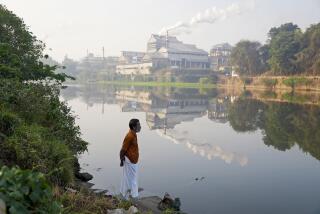India’s Sacred River Sullied by Pollution
- Share via
NEW DELHI — One of India’s holiest rivers, the Yamuna, starts as pristine water coursing down from the Himalayas. By the time it gets to the capital, it’s one of the world’s most polluted.
Raw sewage and trash float alongside frolicking children and elephants. The riverbanks are littered with broken glass, cement blocks and rotting fish.
Environmentalists have taken to calling it the “poison river.” But thousands of Indians still flock there every day to plunge into filth foaming on water turned black by pesticides, trash and other pollutants dumped from factories.
Many Hindus believe they can ward off death by bathing in the Yamuna, which is named after the sister of Yama, the Hindu god of death. They also insist it helps cleanse them of their sins.
On any given day, hundreds of people plunge into the river at various spots, stretching their hands in prayer toward the sky.
For thousands of India’s poor, living in bamboo shack slums on the river’s edge, the Yamuna serves more basic needs: It is their only water source, a place to wash clothes or to escape summer heat.
They are careful to avoid mounds of industrial waste when they dive in. The risks are enormous: Swallowing the water can sometimes produce wrenching stomach ailments. Excessive bathing in it can cause painful rashes and infections, scientists say.
Over the last decade, the Yamuna--the principle water source for some 60 million Indians and most of New Delhi--has become a dumping ground for dozens of hospitals, slaughterhouses and dairies.
According to some estimates, nearly a half-billion gallons of waste spill into the Yamuna each day, as well as tons of pesticides from farms outside the capital.
India’s Supreme Court is finally demanding that New Delhi state take action to save the river, setting a 2005 deadline to clean it up.
More to Read
Sign up for Essential California
The most important California stories and recommendations in your inbox every morning.
You may occasionally receive promotional content from the Los Angeles Times.













